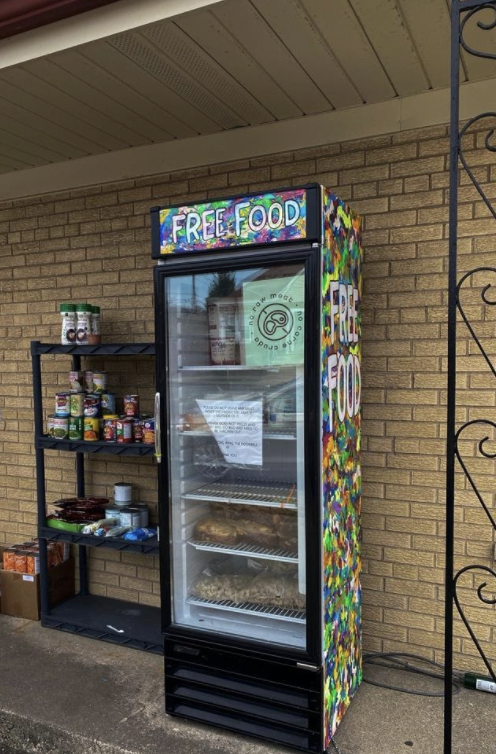Love Fridges in Chicago aid Black and Brown communities amid COVID-19 pandemic
Yesenia Chavez, 26, is a lifelong resident of the Southeast Side of Chicago. Growing up, Chavez witnessed her mother, Irma, helping individuals with different public services. Despite not being a licensed social worker, Irma dedicated her life working in the field since she was 18 years old. Irma is currently the director of a community outreach program for Family Rescue, which provides services to victims, survivors and families impacted by domestic violence.
“My passion is working in public health and doing social work,” Irma said. “I have always enjoyed providing services to communities in need.”
Henry H. Martinez, the former executive director of the now-defunct Mexican Community Committee of South Chicago, served as Irma’s mentor and inspiration for community involvement. In Irma’s years as an activist, she has provided assistance to low-income immigrants, participated in community events and marches, and offered services to individuals impacted by the Department of Children and Family Services.
Her activism extends to food access causes, too. The Greater Chicago Food Depository is a food bank that serves as a resource for families in need across the Cook County area. Irma’s current partnership with the Greater Chicago Food Depository inspired Chavez to give leftover donations from their house to the Southeast Side community.
“My mom always gets a ton of donations from work and brings them home after her scheduled dropoffs,” Chavez said. “I’m like, okay, we have eight bottles of almond milk at our house now. I would tell her we only need two or three bottles, so let me give this back to the community because I’m sure there’s parents or households that need this.”
Chavez and her mother have donated to the Love Fridge at 11201 S. Ave G, known as the Kindness Korner, near their South Chicago home. After getting in touch with the fridge manager at the Kindness Korner, Aracely Galvan, the Chavez family has committed to donate food items on a monthly basis.
“As an active member of this community, giving back is my responsibility,” Chavez said. “I was raised to care for others, whether you knew them or not.”
Throughout the day, residents of the neighborhood are seen either dropping off or taking from the newly painted fridge on Ave G’s busy street. On the Love Fridge’s Instagram page, it was announced on November 16, 2020, that Matt Shapeless Rodriguez, a local Southeast Side artist, decorated the fridge.

The Love Fridge located at 11201 S. Ave G is stocked with a variety of different food products. (Courtesy of Lara Diaz)
Ramon “Radius” Norwood, inspired by fridges to battle food insecurity in Brooklyn, New York, was one of the organizers who brought the vision of Love Fridges to life in Chicago. Love Fridges were created to provide aid to low-income communities by offering a place to get free food. Individuals are encouraged to manage a fridge, become a recurring food donor, or sign up for impromptu donations by reaching out to Risa, the volunteer coordinator.
The project started with only a handful of fridges as it launched in early summer 2020. Now, there are currently over 20 Love Fridges scattered across the Chicago area. An interactive map on the official Love Fridge Chicago website pinpoints locations and accessibilities of each fridge, which are found primarily in Black and Brown neighborhoods.
High unemployment rates in Illinois have left many families uncertain on how to get food on the table. The Economic Policy Institute’s map, updated March 2021, outlines state unemployment rates by race and ethnicity. Upon sorting the map by race and ethnicity, 5.2 percent of Hispanics and 6.7 percent of Black individuals are unemployed in Illinois. In comparison to white individuals in Illinois, only 3.1 percent are unemployed.
“On the Southeast Side, there’s a big issue with nutrition in children and adults,” Chavez said. “Chronic diseases like diabetes and high blood pressure in our community tie directly into malnutrition.”
The Greater Chicago Food Depository provides a map of poverty and food insecurity in Cook County. The majority of Black and Brown communities on the South and West sides are marked as some of the highest areas living below the federal poverty level, which is $26,500 for a household of four people in 2021. No North Side community goes above 40 percent on the map, which is the third highest category out of five.
Love Fridges have been a vital resource for low-income communities during the COVID-19 pandemic — especially on the Southeast Side of Chicago.
“I have seen the impact of many people in need of food and economic assistance during the COVID-19 pandemic,” Irma said. “The Love Fridge is an excellent resource for the Southeast Side community. I really think every community needs to have a Love Fridge.”
Food guidelines for the Love Fridges recommend unopened and nonperishable food items while strongly advising against anything unlabeled, raw or half-eaten. As of now, there is one Love Fridge on the Southeast Side for residents.
With COVID-19 still impacting Black and Brown communities over a year later, the Chavez family has no plans to stop donating. Chavez and her mother hope to continue giving back to the Southeast Side in any way possible.
“I have aspirations to continue donating to the East Side Love Fridge for the future in addition to creating other Love Fridges around the area,” Chavez said. “It gives a sense of pride for the community, it gives people an opportunity to be proud of something and contribute.”
Header image by Yusra Shah




NO COMMENT